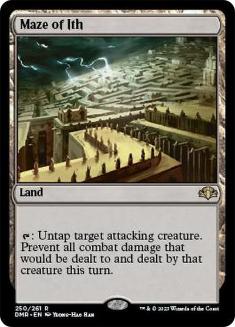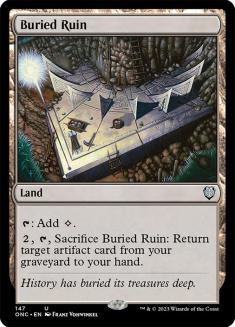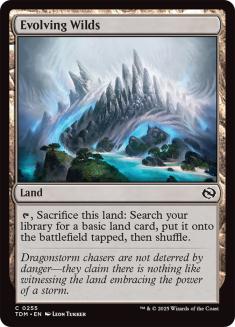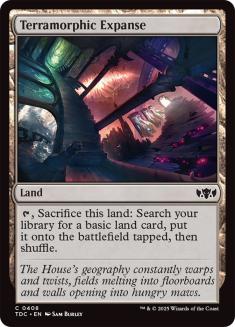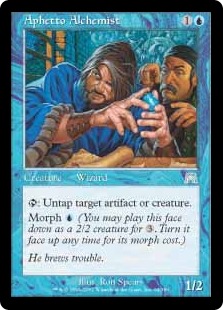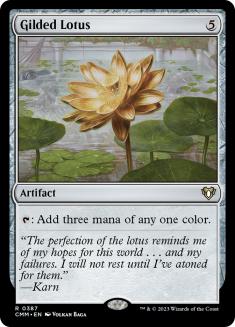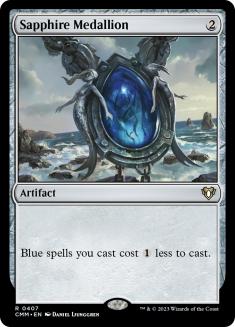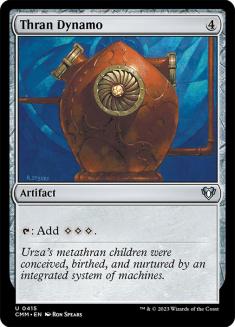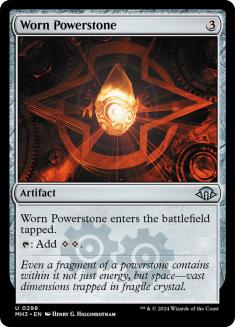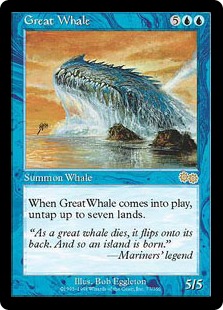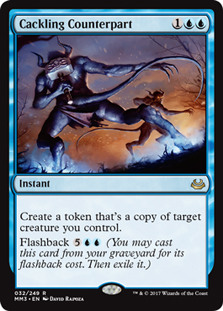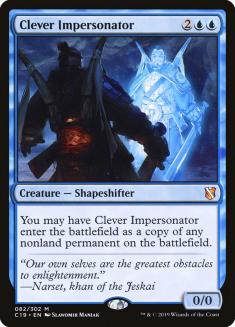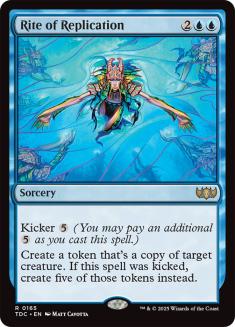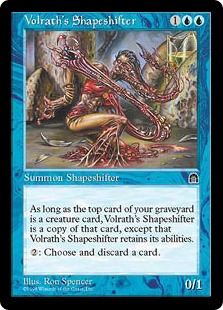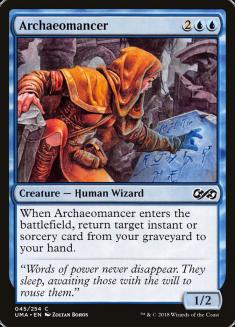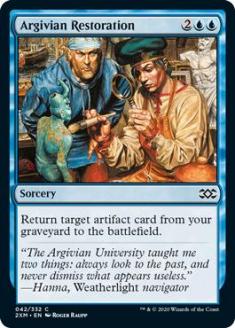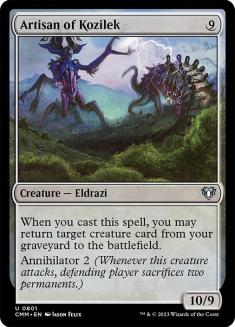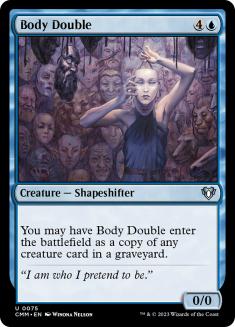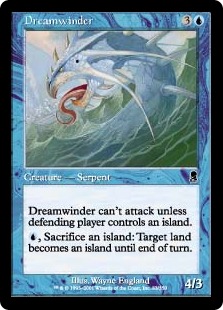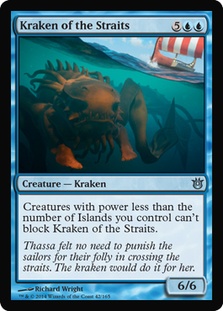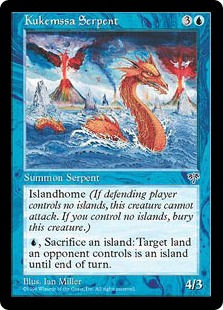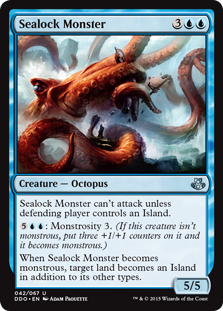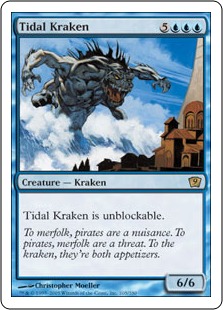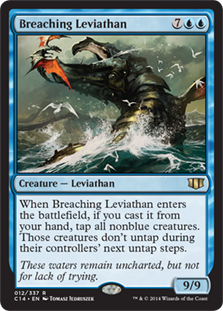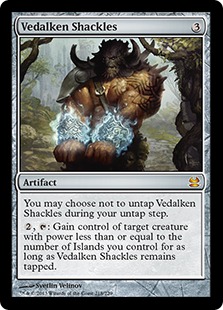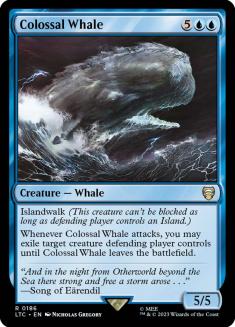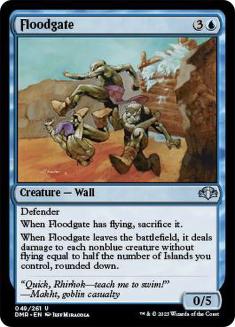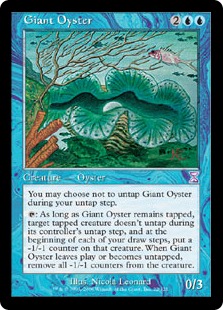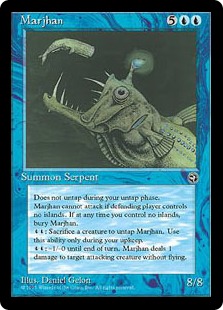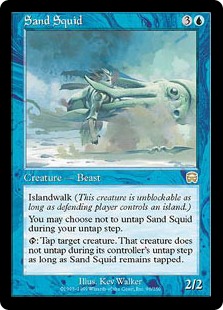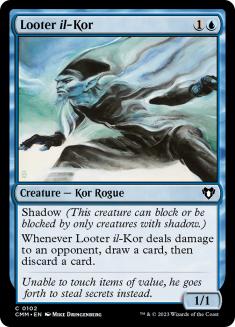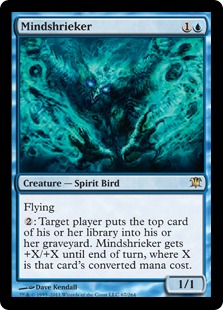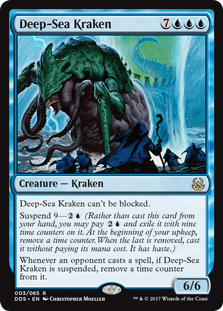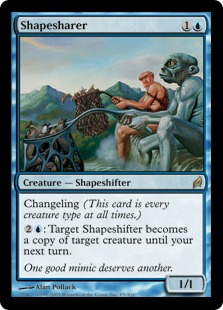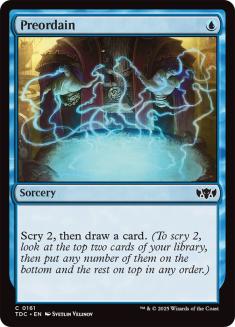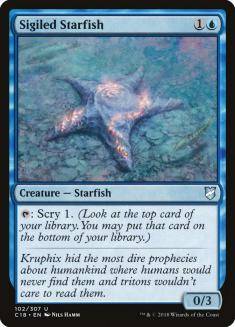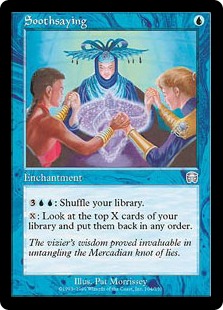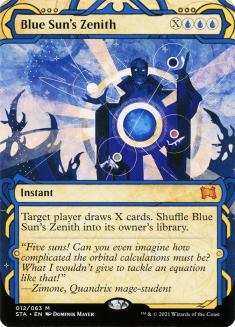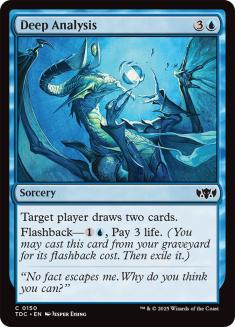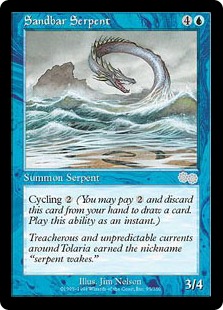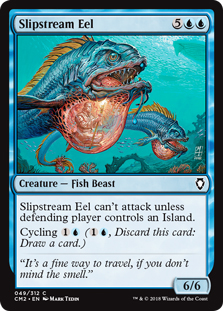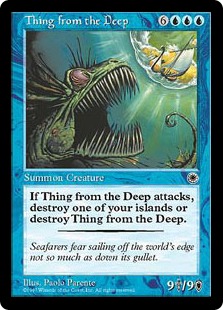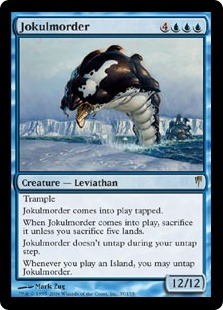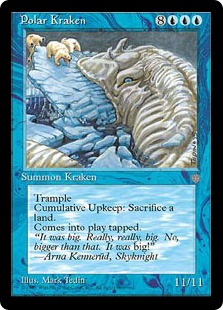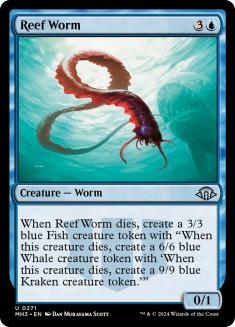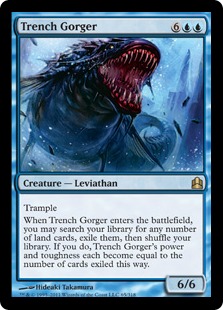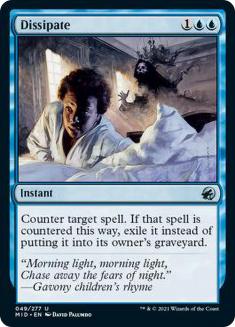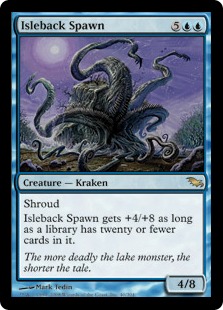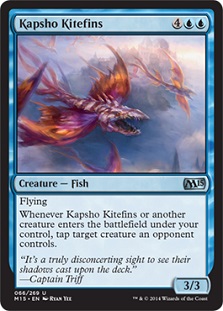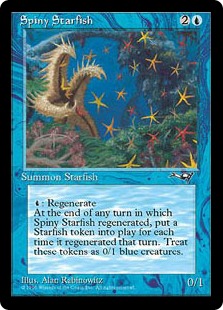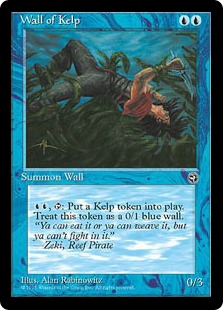Today’s title came directly from this inspiring entry in the “deck doctor the new legends in Commander 2014” theme that Sean and I are running for the next few weeks. Without further ado, take it away Michael!
|
“With a budget of between 60-80 dollars, I present to you: Geralf Goes Fishing There once was a man named Geralf, And he really loved to stitch. Now, one day he went fishing, but he didn’t catch any fish! He caught boots, bodies, and baubles Krakens, and leviathans, He stitched them all together, Suddenly, they were kin! But his creations were hungry, And Geralf wanted to comply, So he invited his friends, But he didn’t tell them why! Wicked Geralf wasted nothing, “Why go fishing anymore? I’ll stitch what’s left together, Then invite over some more!” Commander: Stitcher Geralf Minamo, School at Water’s Edge 32 Island
I think that it’s pretty self-explanatory for the most part, although I do request that you leave in Master of Waves and Mass Polymorph, because, well, Thanks in advance, and I hope you enjoyed the poem! -Michael” |
I did enjoy the poem! It’s always great to see creative entries like this one, and it reminded me a bit of the Walrus and the Carpenter. That’s high praise, since Lewis Carroll set the standard for
nautical poetry that focuses on eating your guests.
Poetry has lost much of its influence in the world, and it’s a shame. What’s left has mostly bled into the musical realm. While there are still plenty of
places to find poetry that’s set to music and performed (rap and folk are particularly deep wells of this type of culture), it’s far rarer to find it
standing alone on the page. It’s left the medium with a bit of an identity crisis, and it’s left a lot of poets working day jobs that have little overlap
with their passions.
I was inspired by the coherence of your theme and as a result, I leaned into it. The changes, as a result of this, made it nowhere near the allocated
budget, even should you foil or otherwise premium out all the cards I added in. I think the synergies of my build should make up for some of the lost
powerhouses, and I think the changes to the curve should better shape your threat profile. With a theme like Krakens, it’s easy to get the rest of the
table petrified that as soon as you do anything they’ll all die to a flood of undead waterlife. By adding in some of the lower power sea creatures, we help
reassure people they’re not going to die to some polymorph combo while still providing fuel for Stitcher Geralf to do his thing.
The Changes
Lands
Out
(5):
In
(3):
We begin on terra firma. I’m a fan of 38 lands, because fewer than that tends to leave you hurting for lands some games, and more than that makes it really
easy to flood out without a readily available draw engine. You were running 40, with Crucible of Worlds backup, so I cut two and then added in some other
lands that work well with Crucible. Terramorphic Expanse and Evolving Wilds recur well if you get Crucible online, and even if they don’t, they’re another
way to shuffle your library post-Brainstorm or whatnot.
I cut Maze of Ith because this doesn’t seem the right deck for it. It’s a defensive card that takes up a land slot, which slightly raises the change of a
blank Stitcher Geralf activation, and it’s not on theme to boot. I cut several powerful cards that were off theme because the theme was awesome, and a blue
deck can be fun without the generic blue powerhouses. When you go to this much effort to make for a flavorful deck that does something a little different
than most blue decks usually do, it seems a shame to dilute that with things that actually weaken your gameplan, even if they do so by adding in a strong
plan B.
Ramp
Out
(5):
In
(1):
As you will see, the biggest thing I did was increase the creature count of the deck. Many of the roles you had been using artifacts and spells to
supplement could be more flavorfully achieved via the use of aquatic creatures. Great Whale is a prime example of this. While it doesn’t provide the same
early advantage you might get from Sapphire Medallion and the mana rocks, you’re running three different mana doublers, and with those the Great Whale
lives up to its name. Since each one of those mana rocks represents a failed cast with Stitcher Geralf, sliding creatures into those slots help reinforce
the themes and the effectiveness of your primary engine.
And since these mana rocks are coming out, that’s a major reason to cut Aphetto Alchemist. I get that the Alchemist was included because it serves triple
duty: it ramps via your mana rocks, gives you extra Stitcher Gerald activations, and untaps the leviathans with annoying untap costs. But once you cut the
mana rocks and minimize the leviathans with drawbacks, the arguments for including the Alchemist wear thin. That having been said, I kept in the
Fatestitcher because it retains some utility when it’s milled out, and it works better with your mana doublers.
Recursion, Duplication, and Evasion
Duplication Out
(5):
Recursion Out
(4):
Evasion In
(5):
Here, I took out two things that blue does well in favor of adding in some of the fish that will help enable your other sea serpents to attack land bound
enemies. The problem with your duplication and recursion themes were that most of the cards represent blanks when you cast your line. Clone, Cackling
Counterpart, Clever Impersonator, Rite of Replication, Volrath’s Shapeshifter, Argivian Restoration, and Body Double all add either zero power or are
ineligible for Stitcher Geralf’s ability. Oh, and Volrath’s Shapeshifter has the irritating requirement of keeping your graveyard ordered, which I dislike
in games of Commander. It’s hard enough to get a good sense of what’s in your own graveyard, let alone an opponent’s, if you can’t sort it. Unless a
“graveyard order matters” card is super on theme, like Ashen Ghoul or Nether Shadow in a graveyard recursion deck, I tend to think it’s not worth the
effort for everyone involved.
Archaeomancer and Artisan of Kozilek are less dead to your primary engine, but they both have their own arguments for getting cut. Archaeomancer is less
powerful if you’re trying to cut down on the spells in your deck, which I am. And Artisan of Kozilek’s main abilities are tied to a cast trigger, not an
enters-the-battlefield trigger, so it’s a bad Polymorph roll. Like, yes, you end up with a giant eldritch horror, but people take being hit with
annihilator very personally. It tends to draw aggro, and the last thing you need is more of that.
Instead, I brought in leviathans that were either personally evasive, or that helped handle the weird islandhome ability that plenty of these sea serpents
were printed with. Kukemssa Serpent and Dreamwinder both handle this by letting you sacrifice an island to turn an opponent’s land into an island until end
of turn. It’s not a great ability, but it has minor synergies with Crucible of Worlds, particularly when you’re doubled. That it can be occasionally used
to harry non-basics like Cabal Coffers is ancillary; the real reason to run them is that they’re four mana 4/3s that let you commit to the board in a way
that keeps people from swinging at you until your haymakers are set up.
Sealock Monster is basically the same, only it’s almost strictly better. You can only use the ability once, but it’s a 5/5 for five to begin, and the
monstrous ability is a serious boost. Kraken of the Straits is generally going to be unblockable, and Tidal Kraken is just unblockable, both of which seem
like good ways to end the game.
Removal
Out
(2):
In
(6):
Breaching Leviathan is another creature I cut because you don’t seem like a deck whose Plan A is to cast these monsters. As such, cards with tetchy cast
triggers seem like they’re worse inclusions, even if they’re on the theme of wet wildlife. Vedalken Shackles is powerful in blue decks, and maybe if it had
been a net I’d consider keeping it (like Conch Horn, the flavor of which makes up for its artifact typing). But it doesn’t; how do you shackle a fish or a
serpent? It’s another generic power card that’s a bad reveal off Stitcher Geralf, so I cut it.
Colossal Whale is the whale that ate Jonah and the Terrible Dogfish from The Adventures of Pinocchio. It’s basically a Journey to Nowhere, but where the
nowhere is the belly of a huge mammal. It’s on theme and one of those cards I think should see some more play. Obviously it’s vulnerable to wrath effects,
but not every deck can be resilient to those.
Of course, if you have Colossal Whale and Floodgate in play, you get some protection from those wrath effects. Floodgate is a weird card, in that it’s a
wall that can turn into a damage-based wrath effect when it dies, and it dies whenever it flies. Good with Wonder, when it’s basically just a direct damage
spell. Super flavorful too, which in my eyes merits its inclusion in a deck that’s seeking to plumb the depths of blue’s oceanic elements.
Giant Oyster is bad removal, but it’s removal, and it’s a nostalgia card with a fishing theme. Sure, it’s a bad flip with Stitcher Geralf, but even that
makes flavor sense: it’s not easy to catch an oyster with a fishing line. Even the Walrus and the Carpenter resorted to deceit.
Kederekt Leviathan is great because it’s a good Stitcher Geralf flip whether or not you exile it. Sure, it’s a big creature, but it also has unearth and a
fairly brutal enters-the-battlefield trigger. There’s even a sweet line of play possible where, in response to a wrath effect, you can Brainstorm it to the
top of your library, and then Jalira, Master Polymorphist to bounce everything back to your hand. That’s not going to happen every game, but I like having
those weird little interactions; half the reason I’m so down on tutor effects in the game is that it flattens your lines of play, and you lose some of the
complexity that can allow for weird cards like Kederekt Leviathan to shine.
Marjhan was a find! As leviathans (or serpents) go, this card has relatively little in the way of drawbacks. Yes, it’s saddled with islandhome and doesn’t
untap normally, but it comes into play untapped, and having a sacrifice outlet in the deck, even one tied to your upkeep, is not the end of the world.
Plus, it’s an 8/8 for seven mana, which is a pretty good rate as these things go. But it’s the final ability that makes it such an interesting card. It’s a
combat pinger with an ability that scales with your mana! And the attacking flightless creature doesn’t even need to be attacking you, you can use it
politically as well. I like it, and it seems like it has some serious potential.
Finally, we have my old friend from reject rare draft: Sand Squid. It’s not the best creature, but it’s on theme, and it can be used both as a tapper and a
pinner as needed. It has islandwalk but not islandhome. Plus, it’s a four-drop, and I made a concerted effort to lower your curve once I took out the mana
rocks.
Low Drops
Out
(2):
In
(2):
Speaking of low drops, I cut two of your off theme low drops in favor of two on theme. Both Looter il-Kor and Mindshrieker seemed like ways to drop cards
into your graveyard, and since this deck isn’t all about the reanimation or recursion, I don’t think that’s necessarily where you want to be. I get that
Mindshrieker also swings an occasionally haymaker, but if you know a big creature is on top of your library, isn’t it better to have a token that sticks
around past the end of turn?
In its place, I brought in Deep-Sea Kraken, which has a low suspend cost and comes off it super early, and Shapesharer, a clone that’s also a leviathan! I
still think you want to be committing to the board from the start of the game, and these cards are primarily good for that reason, even though one’s also
evasive and the other’s also a clone.
Selection
Out
(1):
In
(2):
I kept Ponder and Brainstorm and cut Preordain. Why, one might ask? Well, Brainstorm is easy; it stays in for the same reason you want to play Dream Cache
and Conch Shell. Every once in a while you’re going to want to put one of the big monsters back on top of your library in response to a Stitcher Geralf
trigger or a Polymorph effect. Sometimes you have to throw a fish back, and this is a means for doing so. Ponder was a harder keep. I wish I could say that
the art from the Lorwyn version of the card had nothing to do with my decision, but that would be a lie. Really, the reason was that it digs you three
cards deep, so there are more ways to use the card to set up your Stitcher Geralf activations. Preordain is a lot worse at setting up the stitching,
because only seeing two cards means that you might be forced into drawing a terrible card if you need the other card to turn into a zombie. In some decks
you could just scry away what you don’t need, but half the reason to run these cards is to stack the top of your library, and being able to bottom things
in that situation doesn’t help you do that.
Instead, I brought in one card on theme and one card off theme. Sigiled Starfish is a fun little card, and it’s aquatic to boot. Being able to scry one
repeatedly is useful in Commander, and it’s also a low drop that can help you hold the ground. Soothsaying is off theme, but it’s a great way to stack the
top of your deck. I’m a fan of this card, and I think more blue decks should play it, particularly ones that really care about the top of the library. I
contemplated adding in Scroll Rack, but on average Soothsaying is going to dig deeper, and the shuffle effect works a lot better with Sensei’s Divining
Top, which you are also running.
Draw
Out
(1):
In
(3):
I like Blue Sun’s Zenith in decks where it can either function as a kill spell or a way to keep yourself from getting decked. It’s not serving either of
those roles in this deck, and if it gets milled out you are just out of luck. Deep Analysis, on the other hand, draws you fewer cards, but it has a very
relevant Flashback ability that makes up for it being a dead mill when you’re casting with Stitcher Gee.
Sandbar Serpent and Slipstream Eel are almost the opposite. They’re decent reveals when you’re fishing for zombie food, but if you draw them at an
inconvenient time, you can cycle them away in search of a better card. Every once in a while you’ll just cast them out as beef, as well, since they’ve got
decent (if not amazing) bodies, but for the most part they’re there to provide food for Geralf’s children.
Beef
Out
(2):
In
(3):
Thing from the Deep and Polar Kraken are both somewhat terrible cards, but Polar Kraken has one keyword that makes it a better inclusion: trample. Since
Thing from the Deep can be chump blocked, it may take you more turns to connect with it than it would with Polar Kraken. It’s thus possible you’d have to
burn away more lands for the Thing than for the Polar Kraken, which gets in two solid hits for three lands. Add in the way in which Polar Kraken gives you
bigger zed-words, and I think it makes more sense as an inclusion.
Jokulmorder has trample, but it also may be the worst leviathan ever printed in terms of the viciousness of its drawbacks. It was the worst Polymorph in
your deck. Five lands is a lot of mana, particularly when you’re playing with mana doublers. And for all this drawback, you get a really beefy trampler
with an unreliable untap mechanic. Pass.
Instead, I brought in Trench Gorger. Most of the time it’s just going to be a more expensive 6/6 trampler with no real drawback, but its
enter-the-battlefield trigger is interesting. For a practically invisible cost, you can inflate the thing to colossal proportions, at the expense of a mana
severance effect that might even be to your benefit in the lategame. And because it’s not a cast trigger or anything silly like that, you can do this off a
Polymorph effect as well. It’s a solid card; not for every deck, but a good fit for this one.
Finally, we have Reef Worm. I’m a little surprised it didn’t make it into your deck, to be honest. It’s such a flavorful evocation of the fishing
experience. It’s matsya nyaya, but in a card. It’s also good with almost all your Polymorph effects (excepting Mass Polymorph, of course), and while it’s a
bad reveal off Stitcher Geralf, I think the ways it’s on theme more than make up for this minor drawback.
Defense
Out
(2):
In
(4):
While I am not as against Counterspells as I am against tutors, I still think it’s a type of spell that gets thrown into too many decks just because the
card is good, and if you’re running blue… This is how blue decks flatten in Commander, and I dislike it. It should be possible to make a fun mono-blue deck
without leaning too heavily on the old standbys.
I kept in Scent of Brine though, because it fit the flavor of the deck and doesn’t see as much play. If you must run Counterspells, I would advise at least
running ones that draw you cards. Dream Fracture and Arcane Denial tend to be better for those purposes, since they also piss off people less, but if
you’re less concerned with politics, even running Exclude and Dismiss is better from a card advantage perspective.
Anyway, in place of those one shot defensive spells, I brought in some different ways of holding back aggro. Wall of Kelp is another way to replicate the
Master of Waves/Mass Polymorph shenanigans you wanted to keep, and it’s also a good fit with Kapsho Kitefins to keep an opposing threat tapped down. Since
you can also use Jalira, Master Polymorphist to do something similar, and since it has added value on offense, the flying fish seem like a good addition as
well.
Spiny Starfish is another way to get up to some ridiculously Mass Polymorph effects. Add in the fact it’s fish-themed and can hold the ground forever, and
you can see why I brought it in. It’s basically the blue Will-o-Wisp, and that’s not really something blue should have. Bless Alliances. That set had more
than just Force of Will in it!
Finally there’s Isleback Spawn. Now, it is possible that it might trigger its growth condition at some point, since Stitcher Geralf is technically engaging
in some mill activity. But really, it’s in there because it’s a 4/8 with shroud. If your metagame is anything like mine, there’s not a ton of pump effects
being played. As a result, a 4/8 that can’t be targeted is going to stonewall a ton of opposing threats, even before it undergoes its lategame transition
into a truly gargantuan threat.
The Updated List
So here’s where I ended up with Geralf Goes Fishing, our tribal aquatic deck.
Creatures (41)
- 1 Tidal Kraken
- 1 Wonder
- 1 Great Whale
- 1 Slipstream Eel
- 1 Wall of Kelp
- 1 Marjhan
- 1 Giant Oyster
- 1 Spiny Starfish
- 1 Polar Kraken
- 1 Kukemssa Serpent
- 1 Floodgate
- 1 Sand Squid
- 1 Sandbar Serpent
- 1 Dreamwinder
- 1 Grozoth
- 1 Deep-Sea Kraken
- 1 Shapesharer
- 1 Isleback Spawn
- 1 Fatestitcher
- 1 Kederekt Leviathan
- 1 Inkwell Leviathan
- 1 Serpent of the Endless Sea
- 1 Lorthos, the Tidemaker
- 1 Stormtide Leviathan
- 1 Trench Gorger
- 1 Colossal Whale
- 1 Shipbreaker Kraken
- 1 Thassa, God of the Sea
- 1 Sealock Monster
- 1 Master of Waves
- 1 Tromokratis
- 1 Kraken of the Straits
- 1 Sigiled Starfish
- 1 Scourge of Fleets
- 1 Chasm Skulker
- 1 Jalira, Master Polymorphist
- 1 Kapsho Kitefins
- 1 Pearl Lake Ancient
- 1 Stitcher Geralf
- 1 Reef Worm
- 1 Stormsurge Kraken
Lands (38)
Spells (21)
- 1 Sensei's Divining Top
- 1 Brainstorm
- 1 Soothsaying
- 1 Sol Ring
- 1 Crucible of Worlds
- 1 Lightning Greaves
- 1 Extraplanar Lens
- 1 High Tide
- 1 Conch Horn
- 1 Polymorph
- 1 Dream Cache
- 1 Scent of Brine
- 1 Deep Analysis
- 1 Ponder
- 1 Quest for Ula's Temple
- 1 Crab Umbra
- 1 Mass Polymorph
- 1 Caged Sun
- 1 Swiftfoot Boots
- 1 Whelming Wave
- 1 Polymorphous Rush

Now, the changes I made came in way below your $60-80 budget. I could have shot for the budget and made it into a more generically powerful deck, but I
think that would have ended up with a much less entertaining end product. This is a deck that’s going to play a little differently from your typical
mono-blue deck. If you want to see a more generically powerful mono-blue update, check out the Teferi, Temporal Archmage build I wrote about the other week.
That’s a good starting point, especially if you add back the Vedalken Shackles and Maze of Ith and other generically powerful cards.
The sad truth is that leviathans, serpents, and kraken don’t make for the most expensive tribe. Here’s how cheap they ended up being:
|
In |
$$$ |
|
0.15 |
|
|
0.15 |
|
|
0.15 |
|
|
0.15 |
|
|
0.25 |
|
|
0.25 |
|
|
Floodgate |
0.25 |
|
0.25 |
|
|
0.25 |
|
|
0.25 |
|
|
0.25 |
|
|
0.25 |
|
|
0.25 |
|
|
0.25 |
|
|
0.49 |
|
|
0.49 |
|
|
0.49 |
|
|
0.49 |
|
|
0.49 |
|
|
0.49 |
|
|
0.75 |
|
|
0.75 |
|
|
0.99 |
|
|
0.99 |
|
|
1.49 |
|
|
1.49 |
|
|
1.99 |
|
|
2.99 |
|
|
4.99 |
|
|
22.47 |
As always, this week’s lucky entrant will receive a $20 store credit. Normally that goes to less of the cost of the upgrades, but like I said, serpents are
cheap.
That wraps up today’s entry in the Dear Azami canon. I hope you like the upgrades, Michael, and I hope everyone else found this entry entertaining. If
you’re interested in learning more about the life aquatic, the film Blackfish may be a good place to start.
One final housekeeping note, we are still accepting submissions for the final three commanders to complete the Commander 2014 cycle. That’s Titiana,
Protector of Argoth, Ghoulcaller Gisa, and Jazal Goldmane, to be precise; submit some cool lists utilizing those generals, and Sean or I will choose
amongst your entries while making our determination of which list to doctor over the next few weeks. As you may know, all accepted submissions get their
submitter a $20 store credit for use towards the suggested upgrades, so submit! SUBMIT!!!
Want to submit a deck for consideration to Dear Azami? We’re always accepting deck submissions to consider for use in a future article. Only one deck
submission will be chosen per article, but being selected for the next edition of Dear Azami includes not just deck advice but also a $20 coupon to
StarCityGames.com!
Email us a deck submission using this link here!
Like what you’ve seen? Feel free to explore more of Dear Azami here, in the Article Archives!
And feel free to check Jess’s own Command of Etiquette
column on Hipsters of the Coast, for more Commander and casual content.


